Google recently added an extra “E” to the search quality standards of E-A-T to ensure content is helpful and relevant.
The extra “E” stands for “experience” and precedes the original E-A-T concept – expertise, authoritativeness and trustworthiness.
We know that E-A-T was already of high importance. Hyung-Jin Kim, VP of Search at Google, confirmed this at SMX Next:
“E-A-T is a template for how we rate an individual site. We do it to every single query and every single result. It’s pervasive throughout every single thing we do.”
To rank at Google’s SERPs, you must demonstrate E-E-A-T in your content strategy.
This comprehensive overview will dig deeper into E-E-A-T – specifically what it means, why it matters to SEO, and how to use it to your advantage.
In this article:
E-E-A-T: What does it mean for SEO and why is it important?
Trust is earned by demonstrating experience, expertise and authoritativeness, according to Google’s search quality rater guidelines.
As a ranking factor, E-E-A-T feels more than reasonable. After all, in the real world, we trust sources who are qualified and would prefer to get information or advice from authoritative people.
Google provides a perfect example of this in the Google Search Central Blog, pointing out that if you want to find tax information, you’ll want to see content produced by an accounting expert.
A tax advisor or accountant would be a highly desirable source since they have experience, expertise and authority on the subject, so we trust what they have to say. We can be sure we’re getting accurate and sound information.
Google wants to provide accurate information to its users, so to gain traction in SERPs and get your site to the top spots, you need to demonstrate E-E-A-T.
Demonstrating E-E-A-T to Google
SEO is highly accountable for delivering what’s needed to meet E-E-A-T standards, but what does it mean exactly and how do you prove experience, expertise, authoritativeness and trustworthiness?
The good news is most conscientious website administrators, SEOs, and marketing teams are already doing what they need to and developing E-E-A-T right now.
The Stanford Persuasive Technology Lab compiled 10 guidelines for building web credibility based on three-year research with over 4,500 participants.
- Make it easy to verify the accuracy of the information on your site.
- Show that there’s a real organization behind your site.
- Highlight the expertise in your organization and in the content and services you provide.
- Show that honest and trustworthy people stand behind your site.
- Make it easy to contact you.
- Design your site so it looks professional (or is appropriate for your purpose).
- Make your site easy to use – and useful.
- Update your site’s content often (at least show it’s been reviewed recently).
- Use restraint with any promotional content (e.g., ads, offers).
- Avoid errors of all types, no matter how small they seem.
– Stanford Web Credibility Research
If the above doesn’t scream, “Be a human, care about your users and your website experience,” I don’t know what does.
Let’s break down E-E-A-T and see how SEO can influence it with the above guidelines in mind.
Experience
Think of lived experience – specifically, first-hand experiences on the topic you’re writing about.
Experience is especially important in a digital world moving toward generative AI content.
AI can never demonstrate true experiences of anything. At best, it can make assumptions about the human experience, but the content it generates won’t be unique.
It’s probably no coincidence that Google announced the addition of “experience” in its search quality raters guidelines shortly after ChatGPT’s launch.
Experience is a core differentiator between human- and AI-written content.
You can showcase your experience by sharing the faces behind your website. This statement lines up with Stanford’s web credibility guidelines to:
- Show that there’s a real organization behind your site.
- Highlight the expertise in your organization and in the content and services you provide.
- Show that honest and trustworthy people stand behind your site.
Achieving this doesn’t have to be complicated. Consider a well-thought-out About us page to share your team’s credentials and qualifications.
Think of what makes you feel safer before you spend your money on a product or service and transfer that to the digital world.
Expertise
Expertise relates to the extent of knowledge demonstrated within your article or by the writer.
The rater guidelines suggest that an author’s expertise or authoritativeness on a subject would count considerably toward demonstrating expertise.
But there’s some evidence suggesting that an author’s authority as an individual doesn’t matter to E-A-T (dare I say, yet).
Take a look at this WordStream article. The author is unknown, yet a search for “Google E-A-T” brings “unknown’s” article to the prime position at the top of Google with a sought-after featured snippet.
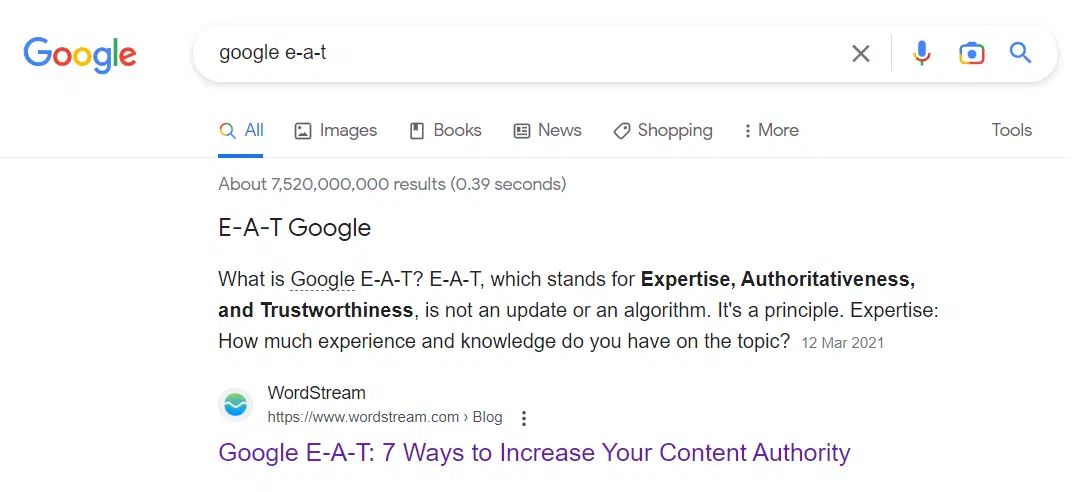
You can bet that Google values this article as the best one to rank, and it’s probably received more than its fair share of clicks.
Although author authority doesn’t seem to influence Google’s E-E-A-T guidelines in this example, I wouldn’t be too quick to dismiss it.
WordStream is likely perceived as a highly authoritative website on this matter. Plus, author expertise is detailed in the quality rater guidelines (more on this in the Tips section).
As AI content rises further and Google’s algorithm gets more sophisticated, it can’t hurt to demonstrate an author’s expertise on a subject.
Besides, expertise will build confidence with the human reading your content, so I would still consider adding:
- The author’s name.
- A descriptive bio containing:
- Their relevant qualifications.
- Links to their social media profiles.
- A Person schema with relevant properties for certifications or professions.
Building trust with your audience will result in other positive engagements that indicate to the algorithm that your site is one to trust and rank.
Moreover, Google’s search quality raters guidelines are clear on what experience entails:
“…which would you rather trust: home electrical rewiring advice from a skilled electrician or from an antique home enthusiast who has no knowledge of electrical wiring.”
In the case of the WordStream article, it may be that the site itself had enough authority on the subject of Google E-A-T that it could rank with an unknown writer.
Authoritativeness
Authoritativeness considers the extent to which a content creator is known as a go-to source on the topic.
Authority can be demonstrated in three core ways:
- Establishing a strong content architecture covering all aspects of a particular topic.
- Earning backlinks from other authoritative sites.
- Building a digital profile or personal brand as an expert in a particular topic.
Authority, expertise and experience go hand in hand. You can’t be an authority on a topic without experience and expertise, and vice versa.
Let’s dig further into the ways you can build authority using SEO.
Content architecture and topical authority
Building topical authority makes sense to appease Google E-E-A-T and applies in the real world.
Think about it this way…
If you were hiring an SEO consultant who could tell you about keywords, you might consider them fairly authoritative.
If the same SEO could tell you about keywords, backlinks and technical SEO with confidence, they’re going to seem even more authoritative.
If the SEO could do all of the above and prove their expertise through case studies (experience) and relate SEO to other forms of marketing, they’re going to seem highly authoritative.
You’re more likely to trust and hire the person with the most amount of authority.
Regarding E-E-A-T, you can demonstrate authoritativeness with a solid content strategy.

Your content strategy should consider everything your potential buyer/site visitor will want to know. Develop and document a strategy to deliver answers in a way that exhibits E-E-A-T in every article.
The more high-quality content successfully indexed by Google, the more authoritative your site becomes on a particular subject.
Once again, the idea of publishing content that is truly helpful supports Standford’s web credibility guidelines:
- Make it easy to contact you.
- Make it easy to verify the accuracy of the information on your site.
- Design your site so it looks professional (or is appropriate for your purpose).
- Make your site easy to use – and useful.
- Update your site’s content often (at least show it’s been reviewed recently).
- Use restraint with any promotional content (e.g., ads, offers).
- Avoid errors of all types, no matter how small they seem.
Helpful content that supports buyers through their journey will naturally achieve all of these items.
Backlinks from authoritative sites
Although they carry less weight than they used to, backlinks are still an indicator of an authoritative site. If someone links to your site referencing information you published, this is a sign that you can be trusted.
Earning backlinks from other authoritative sites will also indicate that your site is trustworthy. The critical thing to note is that authority refers more to topical authority relating to expertise and experience and not domain authority.
For example, Google recognizes Search Engine Land as an authority in SEO. A search for “SEO publications” ranks Search Engine Land on Page 1. At the bottom of SERPs, Google associates Search Engine Land as an SEO source.
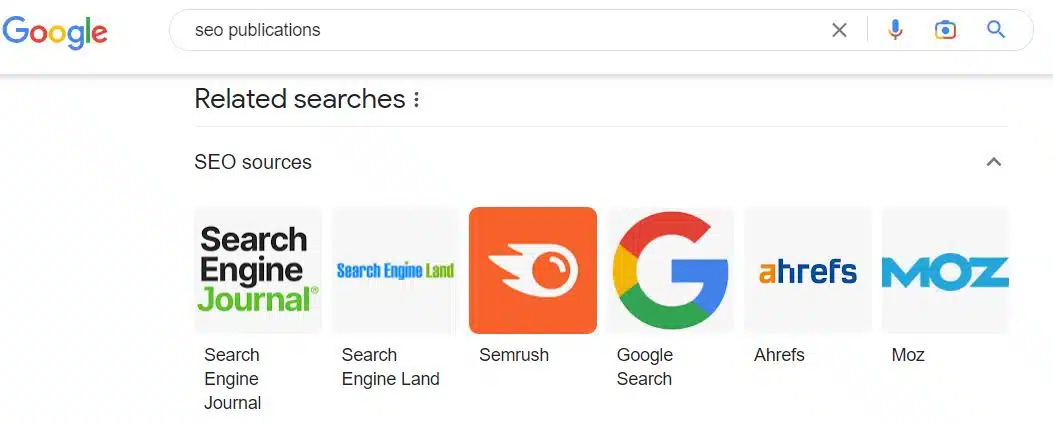
As a trusted website, a link from Search Engine Land to an article carries some weight.
Google knows it can trust Search Engine Land when it comes to SEO, so if there’s an external link to a topically relevant website (say an SEO study or research), it will add some indication that the linked site can also be trusted.
Building a digital profile or personal brand
If you can show Google who you are and what you do, you can establish authority and expertise on a particular subject.
Sara Taher, an SEO consultant and speaker, achieves this with great success. Taher’s knowledge panel clearly says she is a “Canadian-based SEO consultant.”
The panel has her social links and shares details of her authored pieces.
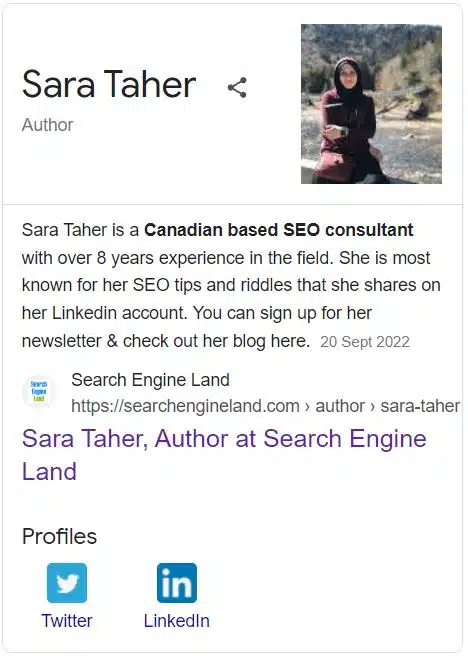
We can see that Google knows Taher is an authority on SEO. With this in mind, it’s unsurprising that Taher has articles ranking number 1 in Google for SEO-related topics.
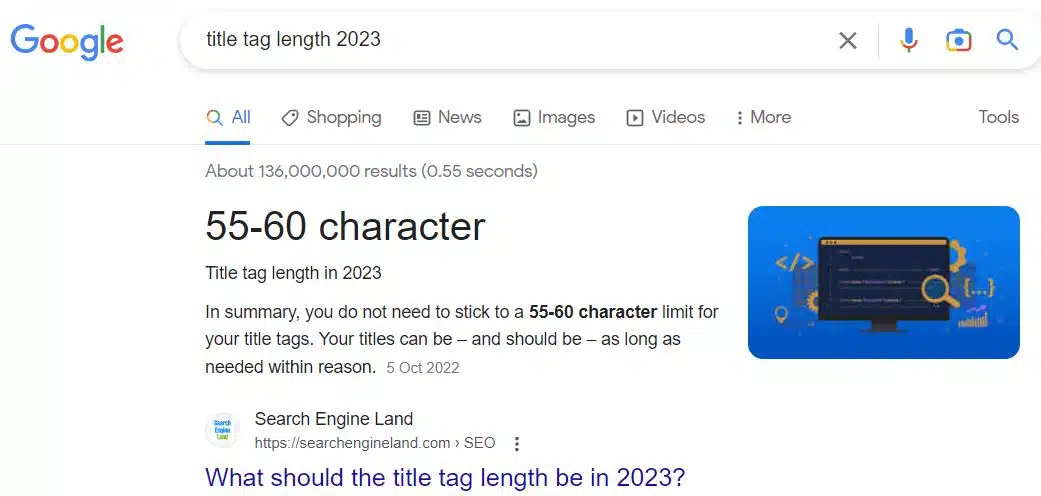
Trustworthiness
When we break it down, we’ll see that trust is developed by showcasing experience, expertise and authority in aggregate.
Building E-E-A-T is a long-term process. Be mindful of these core pillars when creating a content strategy so SEO can work properly.
Get the daily newsletter search marketers rely on.
Levels of E-E-A-T
E-E-A-T is a wide spectrum, and some sites have higher levels of E-E-A-T than others.
Within Google’s search quality rater guidelines, there’s guidance on what E-E-A-T looks like at various levels.
The aim is to build E-E-A-T to the highest possible level, but every website will need to move through the levels over time – likely years.
It’s worth noting that most websites won’t have low E-E-A-T, provided the content they’re putting out there is genuinely helpful.
The lowest E-E-A-T websites will look and read spammy. Equally, high levels of E-E-A-T will be challenging to achieve.
Website owners must aim to share good knowledge and build topical clusters that serve buyers at every step of their journey.
All that said, it’s good to know what the different levels of E-E-A-T look like according to the guidelines.
Lowest E-E-A-T
Pages with the lowest E-E-A-T will probably look and feel spammy to the human eye. Interestingly, the lowest E-E-A-T pages fail to meet an optimal page experience.
“Obstructed or obscured MC [main content]” relates more to page experience than anything else.
Pages with the following characteristics should be considered untrustworthy:
- Inadequate information about the website or content creator for its purpose.
- Lowest E-E-A-T or Lowest reputation.
- Deceptive purpose, deceptive page design, or deceptive intent.
- Deliberately obstructed or obscured MC.
- Characteristics of scams, malicious downloads, or other harmful behavior.
- Any webpage or website designed to manipulate people into actions that benefit the website or other organization while causing harm to self, others, or Specified Groups.
Lacking E-E-A-T
The rater guidelines suggest that a website can lack E-E-A-T on a subject despite having a positive reputation elsewhere. This suggested that page and topical relevancy is of high importance.
As detailed below, it wouldn’t make sense for a cooking website to share a tax form download. It no longer matters that the cooking might be otherwise trustworthy if the topical relevance is low.
Low-quality pages often lack an appropriate level of E-E-A-T for the topic or purpose of the page. Here are some examples:
- The content creator lacks adequate experience (e.g., a restaurant review written by someone who has never eaten at the restaurant).
- The content creator lacks adequate expertise (e.g., an article about how to skydive written by someone with no expertise in the subject).
- The website or content creator is not an authoritative or trustworthy source for the page’s topic (e.g., tax form downloads provided on a cooking website).
- The page or website is not trustworthy for its purpose (e.g., a shopping page with minimal customer service information).
Important: The Low rating should be used if the page lacks appropriate E-E-A-T. No other considerations, such as a positive reputation or the type of website, can overcome a lack of E-E-A-T for the topic or purpose of the page.
High level of E-E-A-T
Websites with high levels of E-E-A-T will achieve and demonstrate experience, expertise, authority and trust.

Google describes high E-E-A-T websites as news or government sites but also highly relevant videos, small business websites and blog posts.
Don’t be dismayed about achieving high levels of E-E-A-T. Every website has a chance!
Very high level of E-E-A-T
Websites that showcase the highest levels of E-E-A-T will look good to the user.
High E-E-A-T pages will satisfy search intent and will be home to high-quality, well-written articles with evidence of knowledge and expertise.
In the documentation, Google says:
“The standards for Highest quality MC may be very different depending on the purpose, topic, and type of website. Here are some examples of Highest quality original content:
- For news : Original reporting that provides information that would not otherwise have been known had the article not revealed it. Accurate, original, in-depth, and investigative reporting requires a high level of skill/talent and effort. Very high quality news content will include a description of primary sources and other original reporting referenced during the content creation process. Very high quality news content must be accurate and should meet professional journalistic standards.
- For artistic content (videos, images, photography, writing, etc.): Unique and original content created by highly skilled and talented artists or content creators. Such artistic content requires a high level of skill/talent and effort. If the artistic content is related to a YMYL topic (e.g., artistic content with the purpose of informing or swaying opinion about YMYL topics), YMYL standards should apply.
- For informational content: Original, accurate, comprehensive, clearly communicated, and should reflect expert consensus as appropriate. Expectations for different types of information may vary. For example, scientific papers have a different set of expectations than a social media post sharing information about a hobby such as stamp collecting. However, all types of very high quality informational content share common characteristics of accuracy and clarity of communication, in addition to meeting standards appropriate to the topic or field. The Highest rating may be justified for pages with very satisfying MC created with a very high level of effort, originality, talent, or skill.”
When building a level of E-E-A-T, asking if something feels right on your website is essential.
Aim to be consistently useful across the site, showcasing genuine knowledge and expertise, and you should meet E-E-A-T.
SEO tips for achieving E-E-A-T
The most conscientious of us are already on the trajectory of achieving high levels of E-E-A-T, but if you’re still unconvinced or’d like a steer, here are some tips.
Consider page experience
Google algorithms tend to build on and evolve rather than supersede each other. Although we heard about page experience a while back, it is still imperative.
Look at the National Heart, Lung and Blood Institute’s BMI calculator page. In the rater guidelines, Google classifies it as having the highest E-E-A-T.

As seen from the screenshot, the page quality rating and explanation consider plenty of factors, including the reputation and expertise on medical topics and the general functionality of the page.
The page’s functionality and the BMI calculator’s usability feed into its E-E-A-T.
Get technical
It’s not much of a leap to assume that if functioning page experiences matter, then so does the website’s functionality.
Keep your site tidy and maintain technical SEO foundations, like:
- Reducing 404s which result in a poor user experience.
- Reducing crawl rate so Googlebot can find all the good information on your site and not duplicate or missing pages and daisy-chained redirects.
- Adding alt text to your images, so all users have a positive experience.
Show your humans with an About us or Team page
The new “E” is here for a good reason, so showcase your experience.
As mentioned, consider all the points and frictions in the real world. What do your customers need to see to feel they can trust you?
If I were hiring a lawyer, for example, I’d want to know who they are, what their expertise is and what their credentials are. Put this information on your website
Lawyers and service-based businesses can showcase their experience online in a way that is easy to understand.
On their team page, BD&P Law showcases experience, education, professional involvement and awards. This helps Google build a picture of who each team member is.
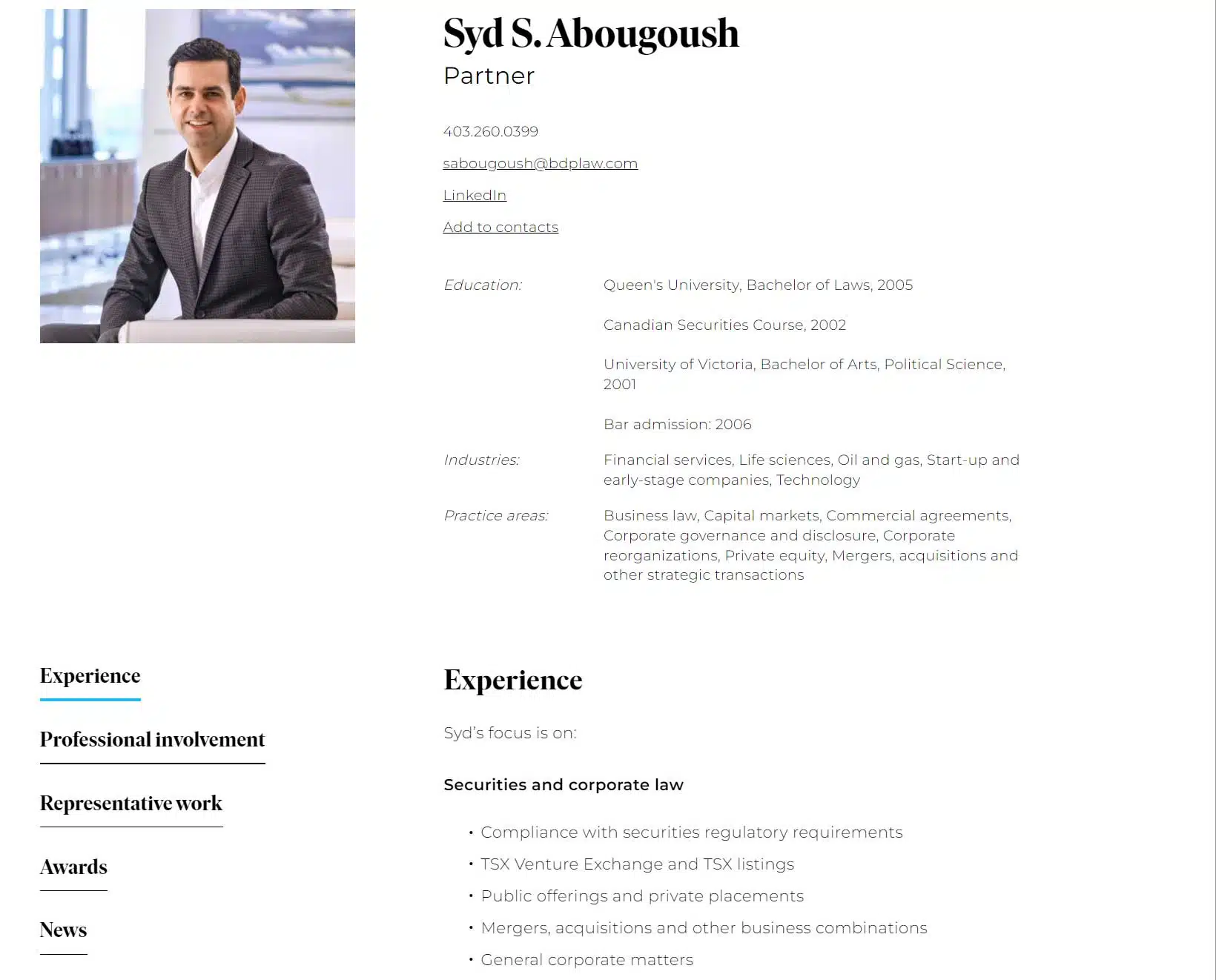
All this information is helpful to Google and useful for a person needing a lawyer.
Another option is creating an Awards page if your specific industry values them.
Link to authoritative sources
You wouldn’t have known everything you know now without researching and learning from other credible sources, right?
Don’t be afraid to link to the sites that helped you develop your content, particularly in article/blog writing.
Linking to credible resources shows you’ve done your research, allowing your user to read related content (don’t worry, they’ll come back!). Google can also verify the information you’re sharing.
Add or update content regularly
Add new content as regularly as you can to keep your site competitive. This give you something to share with your target audience and shows Google you’re active and in business.
Don’t forget to update existing content. Some queries demand updates such as breaking news, product releases or reoccurring events (TV shows, the Olympics, sporting events and more).
Naturally, Google will prioritize updated pieces of content in these instances. But I wouldn’t sleep regularly for a site outside the above categories.
At the turn of the New Year, a joke circulates in the SEO community that we need to update our blogs from “Best Dancing Shoes to Buy in 2022” to “Best Dancing Shoes to Buy in 2023.”
I don’t think this update will pass the E-E-A-T checks as Google inevitably gets smarter. Take your time to update content properly. What’s changed? What else do people need to know?
Perhaps there’s an argument to say that no content is truly evergreen. At some point, it’ll need a little tweak to hold the most recent and trustworthy information.
Build topical clusters
The importance of topical clusters has been mentioned already, but it is crucial to showcase expertise.
You can’t prove subject matter expertise with a single webpage. (Well, maybe you can if it’s book-length content. But I’m not convinced your users want 60,000 words on one webpage.)
Use internal links
If you’ve got articles around a subject, then link them together.
You don’t need to do anything exceptionally clever to build authority through internal links.
Simply link relevant pieces of content together, so it is useful for your audience. Think of a related webpage the user might want to see next.
Include different content types
Content is more than just words on a page. On top of the typical blog post, consider creating:
If a video is the best way to satisfy user intent, use it to your advantage.
Try for a Wikipedia page
Wikipedia is known for having a robust process. It’s not easy to get a Wikipedia page so having one can help you appear more authoritative.
It’ll also help sites earn knowledge graphs in the SERPs – a clear indicator that Google pays attention to Wikipedia.
Engage experts
If you’re adding content to your site, include quotes from experts or have experts write the article.
An article written by someone in-the-know is going to be far more compelling than one that’s not.
A high E-E-A-T blog post on parenting is highlighted in the rater guidelines. It’s written by an author who’s known as an expert on the subject of parenting issues.

You can develop expertise on a subject by building your brand and showcasing your content on other sites through guest posting.
Encourage reviews
Reviews provide proof of expertise. If your customers are happy and Google can see this in the data or entities related to your website (like Google Business Profile), this can only go in your site’s favor.
Final thoughts on E-E-A-T
We know there’s no way to identify a high E-E-A-T website. Instead, Google looks at a multitude of factors.
While it can be an overwhelming concept, it is a straightforward and effective way to gauge content quality.
Treat your web users like your offline customers, know their needs and serve them.
Treat your website like your home or brick-and-mortar store. Keep it tidy and updated, and you should have no problem achieving some decent levels of E-E-A-T.
All this ensures you’re providing value and building trust at every step.
Opinions expressed in this article are those of the guest author and not necessarily Search Engine Land. Staff authors are listed here.

